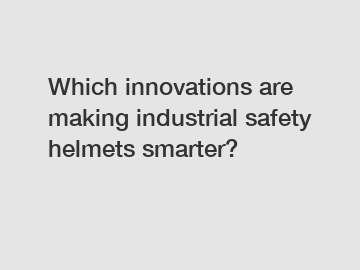Which innovations are making industrial safety helmets smarter?
Which innovations are making industrial safety helmets smarter?
In today's fast-paced world, where technological advancements are taking place at breakneck speed, it should come as no surprise that even the humble safety helmet has undergone a significant transformation. Traditionally designed to protect workers' heads from falling objects and other physical hazards, industrial safety helmets are now getting smarter, thanks to innovative technologies. So, which innovations are contributing to the evolution of safety helmets? Let's explore.
1. Integrated Communication Systems:

One of the most significant advancements in industrial safety helmets is the integration of communication systems. Traditionally, workers had to rely on handheld radios or other communication devices to stay connected on construction sites or in industrial settings. However, with smart helmets, communication systems are seamlessly integrated. These helmets are equipped with built-in microphones, speakers, and radios, which allow workers to communicate with their team members or supervisors without the need for additional devices. This innovation not only enhances productivity but also improves safety by allowing for immediate response in case of emergencies.
2. Augmented Reality (AR) Technology:
Another exciting innovation in the realm of safety helmets is the integration of augmented reality technology. AR technology overlays digital information onto the real world, creating a blended experience. This application has immense potential in industrial settings where workers often encounter complex machinery or hazardous environments. With AR-enabled helmets, workers can access real-time digital information, such as instructions, 3D models, or safety guidelines, directly in their field of view. This technology aids in training, troubleshooting, and optimizing workflows, as it provides workers with instant access to relevant information without diverting their attention from the task at hand.
3. Sensors for Hazard Detection:
Safety helmets are now equipped with sensors that can detect potential hazards in the surrounding environment. These sensors can monitor factors such as temperature, carbon monoxide levels, or even hazardous gases. By constantly analyzing the data collected from these sensors, the helmet can notify the wearer of any imminent danger or trigger an alarm to alert nearby workers. This real-time monitoring significantly reduces the risk of accidents and enables prompt action, thereby enhancing overall safety levels in industrial settings.
4. Impact Detection and Analysis:
Industrial environments are full of potential dangers, and head injuries resulting from impacts are a common concern. To address this issue, safety helmets have evolved through the integration of impact detection and analysis technologies. These intelligent helmets use accelerometers and other specialized sensors to measure the forces acting on the head during an impact event. In case of a significant impact, the helmet can quickly analyze the data and, if necessary, send an alert to supervisors or medical personnel, thereby ensuring that proper care is taken promptly.
In conclusion, the continuous advancements in technology have revolutionized the traditional safety helmet into a smarter and more versatile tool. The integration of communication systems enables seamless team collaboration, while augmented reality technology provides real-time information to workers without distractions. The incorporation of sensors allows for hazard detection and quick response, whereas impact detection and analysis technologies ensure immediate care during head injuries. As industries strive to prioritize worker safety and make significant progress in preventing accidents, these innovations in industrial safety helmets play a crucial role. By embracing these new technologies, industrial sectors can not only enhance safety standards but also optimize efficiency and productivity. With further research and development, the future of industrial safety helmets looks promising, providing workers with an invaluable tool to protect themselves effectively in hazardous environments.
Are you interested in learning more about kn100 mask manufacturers, ffp3 fold flat protective mask, China kn100 class duckbill shaped mask ? Contact us today to secure an expert consultation!

Comments